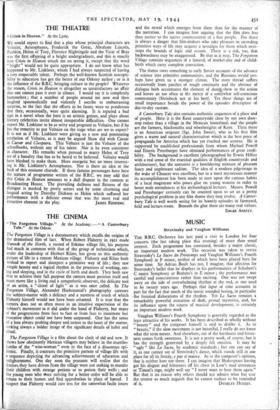THE CINEMA
" The Forgotten Village." At the Academy. " A Canterbury Tale." At the Odeon.
The Forgotten Village is a documentary which recalls the origins of the dramatised film of fact. When Robert Flaherty in 1921 made Nanook of the North, a record of Eskimo village life, his purpose had much in common with that of the group of technicians which, under the leadership of Herbert Kline, has given us this authentic picture of life• in a remote Mexican village. Flaherty and Kline both wished to report and interpret a primitive way of life ; they saw simple beauty and a logical rhythm in the processes of working, eat- ing and sleeping, and in the cycle of birth and death. They both saw that to achieve their full purpose the camera must position itself and must move like a living and a sympathetic .observer, the delicate tool of an artist, a " chisel of light " as it was once called. In The Forgotten Village, Alexander Hackensmid's photography caresses the subject-matter with a delicacy and a sureness of touch of which Flaherty himself would not have been ashamed. It is true that the camera does not so often move in an intuitive expectation of the subject's movement as it did under the hand of Flaherty, but many of the progressions from face to face or from face to inanimate but evocative object could not have been surpassed. One has the sense of a lens always probing deeper and nearer to the heart of the matter, seeking always a bolder image of the significant details of habit and ritual.
The Forgotten Village is a film about the clash of old and new. It shows how obstinately Mexican villagers may believe in the mumbo- jumbo of the " wise woman " even in the face of a disastrous epi- demic. Finally, it contrasts the primitive pattern of village life with a sequence depicting the advancing achievements of education and enlightenment. One day soon the peasants will realise that the doctors they have driven from the village were not seeking to murder their children with strange potions or to poison their wells ; and the young men who were striving for a better order will be able to return to their homes and find approbation in place of hatred. I suspect that Flaherty would care less for the somewhat facile issues and the moral which emerges from them than for the manner of the narration. I can imagine him arguing that the film does less than justice to the native commonsense of a fine people. For there is always a danger that film-makers who take pleasure in recording primitive ways of life may acquire a nostalgia for them which over- steps the bounds of logic and reason. There is a risk, too, that backwardness may be exaggerated. Be that as it may, The Forgotten Village contains sequences of a funeral, of market-day and of child- birth which carry complete conviction.
The theme owes something to early Soviet accounts of the advance of science into primitive communities, and the Russians would per- haps have given us a stronger climax. The story thread suffers occasionally from patches of rough continuity and the absence of dialogue both accentuates the element of durnkshow in the action and leaves us too often at the mercy of a somewhat self-conscious commentary (Steinbeck not at his best). Yet these things are of small importance beside the power of the episodes descriptive of day-to-day custom.
A Canterbury Tale also contains authentic sequences of a place and of people. Here it is the Kent countryside close by our own door- step rather than a village in the Mexican hinterland, and the people are the farmers, blacksmiths and wheelwrights of Kent. Then there is an American sergeant (Sgt. John Sweet), who in his first film gives a warm and natural characterisation which is the best piece of propaganda for America which has yet reached our screens. He is supported by established professionals from whom Michael Powell and Emetic Pressburger have obtained performances of great credi- bility. The background is excellent (photographed by Erwin Hillier with a real sense of the essential qualities of English countryside and architecture), but the narrative is a bewildering mixture of pleasant fancy and unpleasant sadism. The idea of a modern pilgrimage in the wake of Chaucer was excellent, but in a most mysterious manner its accomplishment has been made to turn upon the curious habits of a local magistrate who pours glue on young women in order to boost male attendances at his archaeological lectures. Messrs. Powell and Pressburger certainly can be counted upon to set us a pretty psychological problem in any film theme they may evolve. A Canter- bury Tale is well worth seeing for its homely episodes in farmyard, field and lecture-room. Beneath the glue there are many real virtues.
EDGAR ANSTEY.


























 Previous page
Previous page